

So far, so fun, but if this is all you want from a desktop synth setup, there are many other options available. It’s easy to produce a simple and satisfying four-note sequence, and to add movement by tweaking the low-pass filter and basic attack/decay envelopes. After building the rack and plugging both synths into the included mixer (which also serves as a power distribution unit for the modules) we press play on the Subharmonicon.
MOOG SOUND STUDIO REVIEW PATCH
There’s also an all-important screwdriver, two dice, a pop-up dice game, artwork, stickers and a drawstring accessory bag! Moog packs all this into a box that begs to be opened, and whether you are a synth novice or hardened patch fiend, the charm and allure of all this will no doubt win you over before you even make a sound.Īesthetics aside, a setup such as this will only succeed if the sonics are convincing.

To get you making music immediately, accessories comprise a racking system, mini-mixer, patch cables and patch book. The intent, according to Moog, is to present the ‘complete synthesiser studio experience’ – just add headphones. Both bundles augment these semi-modular pairings with a few other vital accessories. One pairs the DFAM with the Subharmonicon, and the other bundles the DFAM with the Mother-32 (we’re reviewing the former). Next came the DFAM, made for rhythmic analogue percussion sequencing, and then the Subharmonicon, a so-called polyrhythmic analogue synthesizer that’s quite unlike any other self-contained synth on the market.


 0 kommentar(er)
0 kommentar(er)
